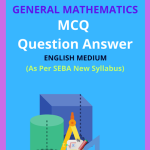SEBA Class 9 Mathematics Chapter 15 Probability Solutions, SEBA Class 9 Maths Textbook Notes in English Medium, SEBA Class 9 Mathematics Chapter 15 Probability Solutions in English to each chapter is provided in the list so that you can easily browse throughout different chapter Assam Board SEBA Class 9 Mathematics Chapter 15 Probability Notes and select needs one.
SEBA Class 9 Mathematics Chapter 15 Probability
Also, you can read the SCERT book online in these sections Solutions by Expert Teachers as per SCERT (CBSE) Book guidelines. SEBA Class 9 Mathematics Chapter 15 Probability Question Answer. These solutions are part of SCERT All Subject Solutions. Here we have given SEBA Class 9 Mathematics Chapter 15 Probability Solutions for All Subject, You can practice these here.
Probability
Chapter – 15
| Exercise 15.1 |
1. In a cricket match, a batswoman hits a boundary 6 times out of 30 balls she plays. Find the probability that she did not hit a boundary.
Ans: Let E be the event of hitting the boundary.
The,
∴ Probability of not hitting the boundary
= 1-Probability of hitting the boundary
= 1 – P(E) = 1 – 0.2 = 0.8
2. 1500 families with 2 children were selected randomly, and the following data were recorded:
| Number of girls in a family | 2 | 1 | 0 |
| Number of families | 475 | 814 | 211 |
Compute the probability of a family, chosen at random, having
(i) 2 girls
(ii) 1 girl
(iii) No girl.
Also check whether the sum of these probabilities is 1.
Ans: Total number of families = 475 + 814 + 211 = 1500
(i) Probability of a family, chosen at random, having 2 girls
(ii) Probability of a family, chosen at random, having 1 girl
(iii) Probability of a family, chosen at random, having no girl
Sum of these probabilities
Hence the sum is checked.
3. Refer to Example 5, section 14.4, Chapter 14. Find the prob- ability that a student of the class was born in August.
Or
In a particular section of Class IX, 40 students were asked about the months of their birth, the fol-lowing graph was prepared for the data obtained.
Ans: Total number of students born in the year
= 3+4+2+2+5+1+2+6+3+4+4+4 = 40
Number of students born in August = 6
∴ Probability that a student of the class was born in Au-
4. Three coins are tossed simultaneously 200 times with the following frequencies of different outcomes:
| Outcomes | 3 heads | 2 heads | 1 head | No head |
| Frequency | 23 | 72 | 71 | 28 |
If the three coins are simultaneously tossed again, compute the probability of 2 heads coming up.
Ans: Total number of times the three coins are tossed = 200
Number of times when 2 heads appear = 72
5. An organisation selected 2400 families at random and sur-veyed them to determine a relationship between income level and the number of vehicles in a family. The infor-mation gathered is listed in the table below:
Suppose a family is chosen. Find the probability that the family chosen is
(i) earing Rs. 10000-13000 per month and owing exactly 2 vehicles.
(ii) earing Rs. 16000 or more per month and owing exactly 1 vehicle.
(iii) earing less than Rs. 7000 per month and does not own any vehicle.
(iv) earing Rs. 13000-16000 per month and owing more than 2 vehicles.
(v) owing not more than I vehicle.
Ans: Total number of families selected = 2400
(i) Number of families earing Rs. 10000 – 13000 per month and owing exactly 2 vehicles = 29
∴ Probability that the family chosen is earing Rs. 10000-
(ii) Number of families earing Rs. 16000 or more per month and owing exactly 1 vehicle = 579
∴ Probability that the family chosen is earing Rs. 16000 or more per month and owing exactly 1 vehicle
(iii) Number of families earing less than Rs. 7000 per month and does not own any vehicle = 10
∴ Probability that the family chosen is earing less than Rs. 7000 per month and does not own any vehicle
(iv) Number of families earing Rs. 1300-16000 per month and owing more than 2 vehicles = 25
∴ Probability that the family chosen is earing Rs. 13000-16000 per month and owing more than 2 vehicles
(v) Number of families owing not more than I vehicle = Number of families owing 0 vehicle + Number of fami-lies owing 1 vehicle
=(10+0+1+2+1) + (160+305+535+469+579)
= 14+2048-2062
∴ Probability that the family chosen owns not more than 1
6. Refer to Table 14.7, chapter 14.
| Marks (out of 100) | Number of Students |
| 0-20 | 7 |
| 20-30 | 10 |
| 30-40 | 10 |
| 40-50 | 20 |
| 50-60 | 20 |
| 60-70 | 15 |
| 70-above | 8 |
| Total | 90 |
(i) Find the probability that a student obtained less than 20% in the mathematic test.
(ii) Find the probability that a student obtained marks 60 or above.
Ans: Total number of students = 90
(i) Number of students obtaining less than 20% in the maths-ematics test = 7
Probability that a student obtained less than 20% in maths-
(ii) Number of students obtaining marks 60 or above =15+8 = 23
7. To know the opinion of the students about the subject statistics, a survey of 200 students was conducted. The data is recorded in the following table:
| Opinion | Number of students |
| like | 135 |
| dislike | 65 |
Find the probability that a student student chosen at random
(i) likes statistics.
(ii)does not like it.
Ans: Total number of students = 200
(i) Number of students who like statistics = 135
∴ Probability that a student chosen at random likes statistics
(ii) Number of students who do not like statistics = 65
∴ Probability that a student chosen at random does not like it
Aliter: Probability that a student chosen at random does like statistics
= 1-probability that a student chosen at random likes statistics
8. Refer to Q.2. Ex. 14.2
The distance (in km) of 40 female engineers from their resi-dence to their place of work were found as follows:
| 5 | 3 | 10 | 20 | 25 | 11 | 13 | 7 | 12 | 31 |
| 19 | 10 | 13 | 17 | 18 | 11 | 32 | 17 | 16 | 2 |
| 7 | 9 | 7 | 8 | 3 | 5 | 12 | 15 | 18 | 3 |
| 12 | 14 | 2 | 9 | 6 | 15 | 15 | 7 | 6 | 12 |
What is the empirical probability that an engineer lives:
(i) less than 7 km from her place of work?
(ii) more than or equal to 7 km from her place of work?
Ans: Total number of female engineers = 40
(i) Number of female engineers whose distance (in km) from their residence to their place of work is less than 7 km = 9
∴ Probability that an engineer lives less than 7 km from her
(ii) Number of female engineers whose distance (in km) from their residence to their place of work is more than or equal to 7 km = 31.
∴ Probability that an engineer lives more than or equal to 7 km
Aliter: Probability that an engineer lives more than or equal to 7 km from her place of residence.
= 1-probability that an engineer lives less than 7 km from her place work.
(iii) Number of female engineers whose distance (in km) from
9. Activity: Note the frequency of two wheelers, three wheel- ers and four wheelers going past during a time interval, in front of your school gate. Find the probability that any one vehicle out of the total vehicles you have observed is a two- wheeler.
Ans: Students, do yourself.
10. Activity: Ask all the students in your class to write a 3-digit number. Choose any student from the room at random. What is the probability that the number written by her/him is divis-ible by 3? Remember that a number is divisible by 3. if the sum of its digits is divisible by 3.
Ans: Students, do yourself.
11. Eleven bags of wheat flour, each marked 5 kg, actually contained the following weights of flour (in kg):
4.97, 5.05, 5.08, 5.03. 5.00. 5.06. 5.08. 5.04, 5.07, 5.00
Find the probability that any of these bags chosen at randcon contains more than 5 kg of flour.
Ans: Total number of bags of wheat flour = 11
Number of bags of wheat flour containing more than 5 kg of flour = 7
∴ Probability that any of the bags, chosen at random, contains
12. In Q. 5, Exercise 14.2 given below, you were asked to pre- pare a frequency distribution table, regarding the con-centration of sulphur dioxide in the air in parts per mil-lion of a certain city for 30 days. Using this table, find the probability of the concentration of sulphur dioxide in the interval 0.12-0.16 on any of these days.
“A study was conducted to find out the concentration of sulphur dioxide in the air in parts per million (ppm) of a certain city. The data obtained for 30 days is as follows:
0.03, 0.08, 0.08, 0.09, 0.04, 0.17, 0.16, 0.05, 0.02, 0.06, 0.18, 0.20, 0.11, 0.08, 0.12, 0.13, 0.22, 0.07, 0.08, 0.01, 0.10, 0.06, 0.09, 0.18, 0.11, 0.07, 0.05, 0.07, 0.01, 0.4”
Ans: Total number of days = 30
Number of days on which the concentration of sulphur diox- ide is in the interval 0.12 0.16 = 2
∴ Probability that the concentration of sulphur dioxide is in the
13. In Q. 1, Exercise 14.2 given below, you were asked to prepare a frequency distribution table regarding the blood groups of 30 students of a class. Use this table to deter-mine the probability that a student of this class, selected at random, has blood group AB.
“The blood groups of 30 students of Class VIII are recorded as follows:
A, B, O, O, AB, O, A, O, B, A, O, B, A, O, O, A, AB, O, A, A, O, O, AB, B, A, O, B, A, B, O.
Represent this data in the form of a frequency distribution table. Find out which is the most common and which is the rarest blood group among these students.”
Ans: Total number of students = 30
Number of student = 30
Number of students having blood groups AB = 3
∴ Probability that a student of this class, selected at ran-dom, has blood group

Hi! my Name is Parimal Roy. I have completed my Bachelor’s degree in Philosophy (B.A.) from Silapathar General College. Currently, I am working as an HR Manager at Dev Library. It is a website that provides study materials for students from Class 3 to 12, including SCERT and NCERT notes. It also offers resources for BA, B.Com, B.Sc, and Computer Science, along with postgraduate notes. Besides study materials, the website has novels, eBooks, health and finance articles, biographies, quotes, and more.









